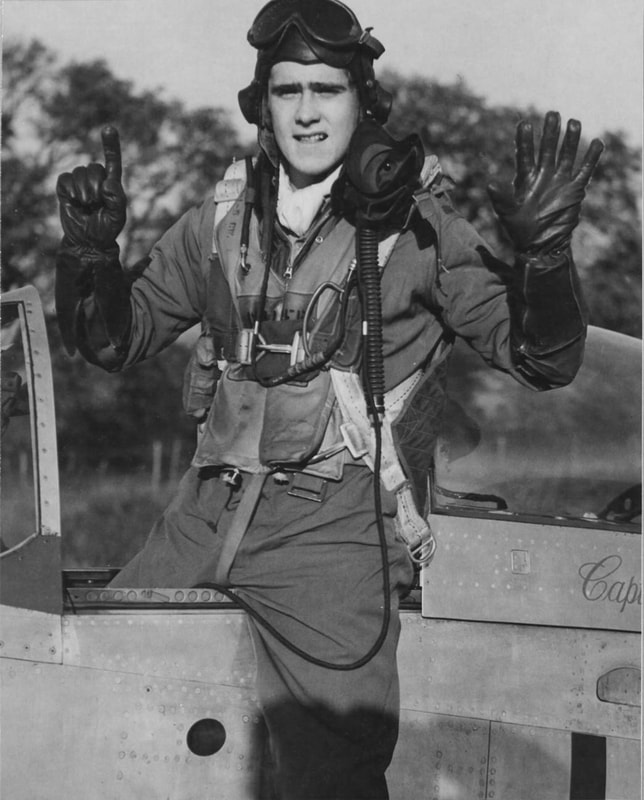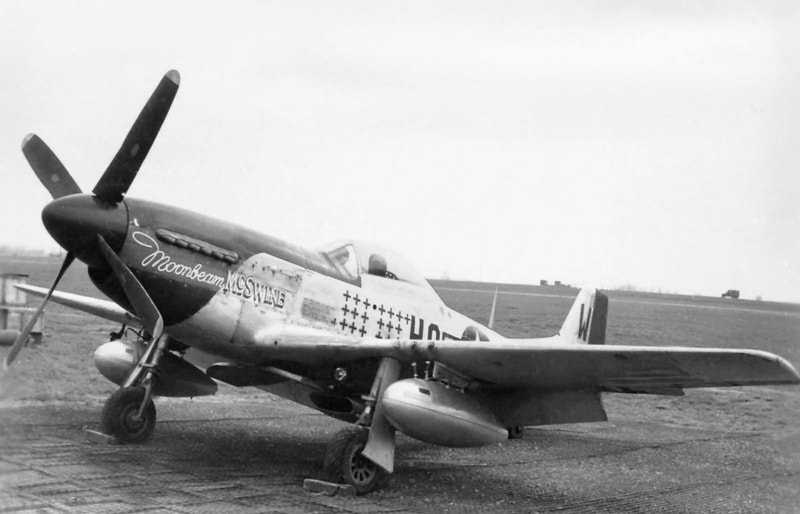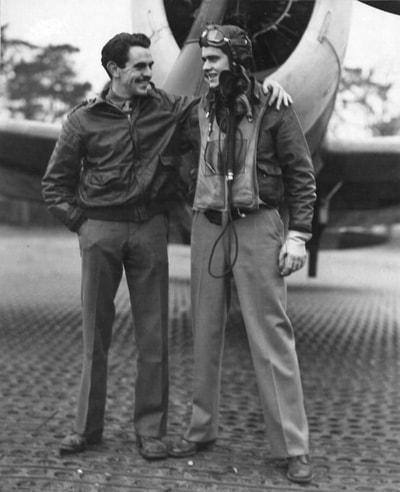William T. Whisner Two War Ace

Oil on Canvas 48"x60"
© 1996 Troy White SOLD
Ltd. Ed. Lithographs are available
In an epic battle on January 1, 1945, Captain William T. Whisner flying his assigned P-51D downs an Me-109 after a head-on pass despite having been hit in the oil tank and wings.
Whisner was already an ace with 11.5 victories notched up when he began his take-off roll on 1 January 1945. His biggest day so far had been on 21 November 1944 when he destroyed five Focke Wulfs and probably destroyed two others in twenty minutes time during a raid on the synthetic oil refineries at Merseburg, Germany. For that feat he earned a Distinguished Service Cross, the USA's second highest award. He scored a double a few days later but without a doubt his most exciting sortie of the war was just about to begin as his air strip was just then coming under attack from about 65 FW 190s and Me109s during the Luftawffe's last large scale offensive operation of the war.
Here is Bill's combat report for New Year's Day 1945:
I was leading Red Flight. As we were taxiing out to the strip I saw some air activity east of the airfield. The squadron consisting of three four-ship flights, was taking off singly. As I started down the strip, Colonel Meyer called the Controller and inquired about bandits in the vic. As I pulled my wheels up, the Controller reported that there were bandits east of the field. We didn't take time to form up, but set course, wide-open, straight for the bandits. There were a few P-47s mixing it up with the bandits as I arrived. I ran into about thirty 190s at 1,500 feet. There were many 109s above them. I picked out a 190 and pressed the trigger. Nothing happened. I reached down and turned on my gun switch and gave him a couple of good bursts. As I watched him hit the ground and explode, I felt myself being hit. I broke sharply to the right, and up. A 190 was about 50 yards behind me, firing away. As I was turning with him, another 51 attacked him and he broke off his attack on me. I then saw that I had several 20 mm holes in each wing, and another hit in my oil tank.
William T. Whisner, 0798190 Captain, Air Corps, 352nd Fighter Group
This was Captain Whisner's fourth kill of the day and Bill's last aerial victory of WWII, bringing his total to fifteen and a half confirmed air, two probably destroyed in aerial combat and three ground victories which put him in the top 20 USAAF aces of the European Theater.. By VE-Day Captain Whisner had flown 127 missions and logged 450 combat hours. His awards included the Distinguished Service Cross with Oak Leaf Cluster, Distinguished Flying Cross with two Oak Leaf Clusters, Silver Star, Air Medal with 12 Oak Leaf Clusters, The European Theatre Ribbon with four battle stars and a Distinguished Unit Ciation.
Whisner also flew F-86s in the Korean War. He shot down two MiG 15s and damaged four others while flying F-86As with the 4th FIW. He then transferred to the 51st FIW and shot down three more MiGs, shared in the destruction of a fourth and damaged two others making him one of only seven American fighter pilots who became aces in two wars. With his combined total of 21 kills, Mr. Whisner ranks as the 18th-leading ace among America's fighter pilots. His Korean War awards include the Distinguished Service Cross, Bronze Star and the Distinguished Flying Cross and the only two-war-ace to win the DFC three times.
Whisner retired from the Air Force as a colonel on 31 July 1972. After retiring he returned to his native state of Louisiana with his wife. Bill died at his home in Alexandria, Louisiana on 21 July 1989, from complications following a yellow jacket sting. He was 65 years old.
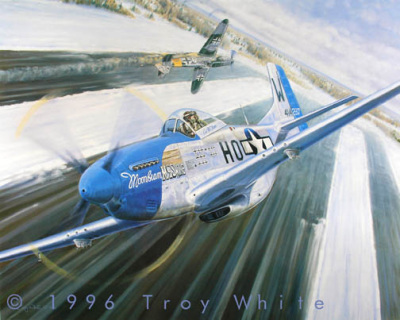
Signed & numbered limited edition print. Edition size: 500. Prints remaining as of 5 November2018: 32. Overall print size: 22" x 28".
In an epic battle on January 1, 1945, Captain William T. Whisner flying his assigned P-51D downs an Me-109 after a head-on pass despite having been hit in the oil tank and wings. This was Capt. Whisner's fourth victory for the day, bringing his total to 15.5. Whisner also flew F-86s in the Korean War, shooting down 5.5 MiGs making him one of a handful of American fighter pilots who became aces in two wars.

Signed & numbered Artist's Proof, edition size: 50. Prints remaining as of 5 November 2018: 5. Overall print size: 22" x 28".
In an epic battle on January 1, 1945, Captain William T. Whisner flying his assigned P-51D downs an Me-109 after a head-on pass despite having been hit in the oil tank and wings. This was Capt. Whisner's fourth victory for the day, bringing his total to 15.5. Whisner also flew F-86s in the Korean War, shooting down 5.5 MiGs making him one of a handful of American fighter pilots who became aces in two wars.
Lt. Bill Whisner's Princess Elizabeth
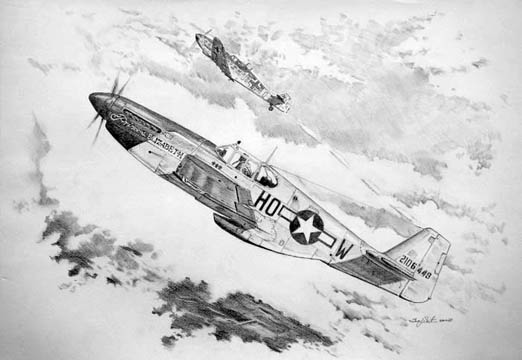
by Troy White © 2010
Graphite on 180 gm textured paper 35x50 cm. FOR SALE
"Princess Elizabeth" P-51B HO-W 42-106449 was the personal mount of Lt. William T. Whisner of of the 487th FS, 352nd FG in the spring of 1944. Lt. Whisner shared a victory over an Me 109 with Major George Preddy on 30 May 1944. This was Whisner's last combat of his first tour. "Princess Elizabeth" was lost with another pilot at the controls on D-Day 6 June 1944.
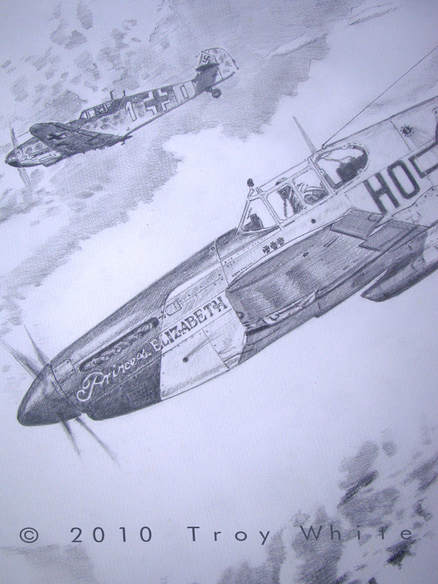
Open Edition Canvas Giclée Print.
Image size: 18" x 12"
Years later Bill Whisner recalled the incident. "...we were withdrawing together after an encounter with FW 109s. I had joined with George and we were low on fuel. George never talked on the radio-- nor did he talk much ever. I called him on the radio and asked his intentions since we were 100 miles inside the continent. No Answer.
He proceeded to head west at 1,000 feet altitude with reduced power. Shortly I saw an airfield ahead and as we were flying about 250 MPH, I suggested to him that we change course and increase speed. No Answer.
We crossed the airfield and to my surprise drew no AA fire. A few minutes later I could see the Channel and the North Sea and again called George on the radio. My words to him were that we needed to increase speed and hit the deck. No answer and no change in George's course of flight.
At this time I had approximately 150 gallons of fuel left and no reason to feel that George had any more or less. When we reached a point approximately two miles short of the coast, I made a right starboard turn of 90 degrees and shoved on full power, and hit the deck, keeping George in my sight to my left. He was obviously intent on keeping the low airspeed and maintaining his altitude. ...Crossing the coast I saw a gun battery and was fired upon as I crossed the coastline. ...I received four rounds of 88mm fire and looked to George. He received four 88mmrounds which missed and then four which bracketed him. He was still flying slow at 500 to 1,00 feet altitude.
At this point I want to say that George Preddy was disdainful of the enemy. He had no respect for nor fear of enemy AA or fighters. Thus, his disregard for my warnings.
I remained on his wing at about 100 feet distance and called him again suggesting that he abandon the aircraft. At this time he began calling Marston for an emergency steer. I had switched to emergency "D" channel, and made no calls until later-- after the bailout.
He began slowing and reducing altitude and finally descended into the cloud (an undercast which topped at about 1,000 feet and and rose to the west in multiple layers as there was a front moving in). At this time he disappeared into the cloud, he was flying at an indicated airspeed of 180 MPH, and he couldn't have seen his instruments due to the heavy smoke in the cockpit. He was flying by the seat of his pants and was in no way panicked.
Rather than stay on his wing after his penetration into the cloud tops, I elected to do a 360 degree turn and enter the cloud in a descent at approximately the same point which he had done. We had not obtained an altimeter setting since before take-off on the mission, and I knew that the low pressure system which had moved in would cause a significant change. I determined therefore that I would penetrate at 180 MPH until I reached an altitude of 100 feet, and no lower. At just above 100 feet I observed waves/foam/water below and suddenly to my right-- I saw a P-47 strike the water. Then, there was a parachute opening and even before I could start a turn George swung once in the chute and hit the water. He had waited almost too long to bail out."
